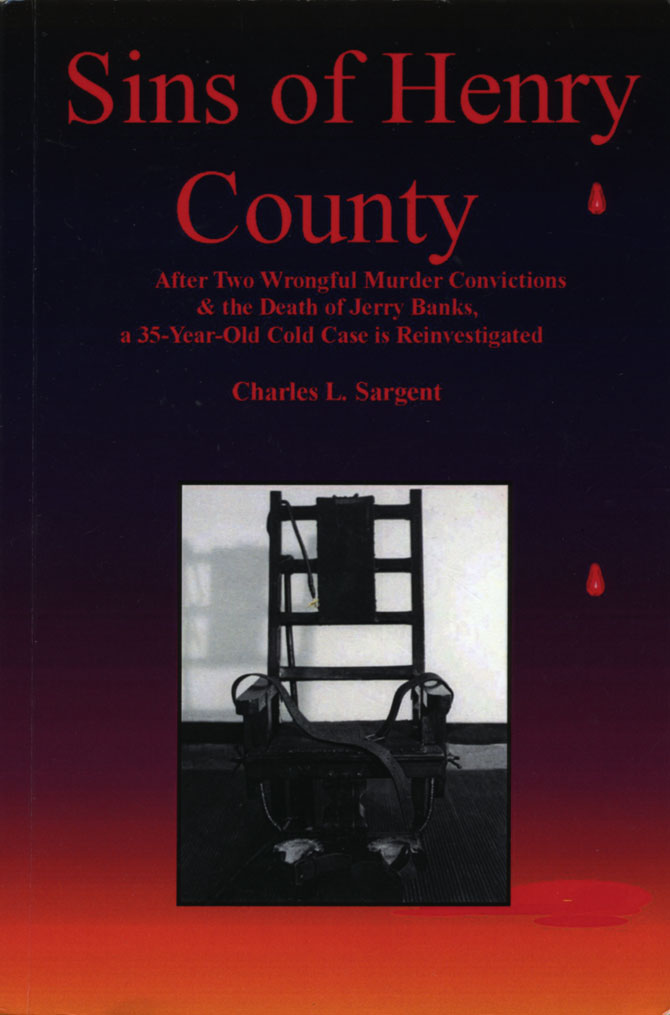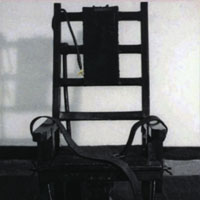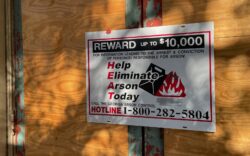“Now I don’t know how killers normally work, but I would guess that if you had just blown two people’s brains all over the place, you would not stand alongside the road waiting for the police, with a shotgun in your hand, particularly if you were black.” —Charles L. Sargent
“Jerry Banks was not convicted on a mistaken identification by a confused witness. Jerry Banks was not convicted because of overwhelming, unfortunate but truthful circumstantial evidence. Jerry Banks was [framed].” —Charles L. Sargent
Charles L. Sargent, a retired Georgia businessman, has written a book that everyone should read and none should forget. It is (amazingly) the first book ever written about one of the most shocking perversions of criminal justice in the history of this state. Sins of Henry County (privately published, available from Amazon, 2012) tells the true but terrifying and tragic story of an innocent man who was railroaded by corrupt police and sent to Georgia’s death row, and of the brutal double murder for which he was framed: execution-style killings which remain unsolved after nearly 40 years.
Marvin King, 38, band director at Jonesboro High School, and Melanie Ann Hartsfield, 19, who attended Clayton County Junior College and was one of King’s former students, were murdered together on a lonely dirt road in a rural part of Henry County around 2:30 p.m. on Nov. 7, 1974. Both victims where white. They were probably taken to the isolated site at gunpoint. While standing near King’s parked car with their backs to their killer, each victim was shot from behind with a shotgun. When they had fallen face-down on the ground, each was shotgunned a second time—this time in the back of the head, causing instant death. The headshots were classic coup de grace wounds designed to make certain the victims did not survive. The killer (probably assisted by at least one accomplice) dragged the bodies to a thicket about 100 feet away and covered them with a blanket taken from King’s car. The car was then driven off and abandoned in a field three miles away.
The only person ever charged with or convicted of the murders was innocent. He was Jerry Banks, a 23-year-old married black man with three children, whose home was less than a mile from the murder site.
Jerry Banks was out hunting with a flimsy, break-top single-shot shotgun when he discovered the bodies about two hours after the slayings. He flagged down a passing motorist, asked him to call police, and patiently waited there for over an hour until police arrived. When they did arrive, Banks led them to the bodies and cooperated fully. Nevertheless, a month after the murders, Banks was arrested and charged with committing them. He was indicted by the grand jury one month later, and put on trial the following month. The trial, which lasted all of four days, resulted in guilty verdicts, and on Jan. 31, 1975—less than 90 days after the crimes—Jerry Banks received two death sentences.
We now know that the criminal proceedings against Jerry Banks were trumped-up. The case against him was a frameup masterminded by police—the Henry County Sheriff’s Office—in charge of investigating the crime. (Because it would require too much space, this book review omits discussing the reasons Sins of Henry County gives as to why police framed Banks.) The evidence of guilt was entirely circumstantial and, except for the ballistics evidence, extremely weak. The ballistics evidence itself was fraudulent in that it was based upon empty shells police planted at the crime scene after firing Jerry Banks’ shotgun. Police who testified repeatedly committed perjury. Exculpatory evidence was suppressed by police. Furthermore, police at the crime scene failed to perform basic investigatory procedures. For example, instead of taking photographs or making casts of suspicious shoe prints they simply made drawings of them! They showed little interest in the old shotgun Banks was holding when they arrived. They didn’t check to see if it had been recently fired; they didn’t inquire what shotgun shells Banks had; they didn’t look to see if there was a spent round in the chamber.

To compound the injustice, Banks’ incredibly inept defense attorney did not adequately investigate or prepare to try the case; and, to put in mildly, he was an unskillful practitioner in the courtroom, utterly failing to mount a meaningful challenge to the evidence against his client. He put only two witnesses on the stand. (The lawyer was later disbarred.)
Although there is no solid proof that they knew police were framing Jerry Banks for a crime he did not commit, prosecutors—the Henry County District Attorney’s Office—must have realized that their theory of the murders was highly unlikely and extremely difficult to believe. A reasonable prosecutor would have noticed that the police investigation was suspiciously irregular and that Banks probably was not guilty. As Sins of Henry County points out, the prosecution’s case requires us to believe that (1) for no apparent motive, Jerry Banks murdered, execution-style, two people he had never seen before in broad daylight using an old, single-shot weapon; (2) Banks dragged two bloodied corpses over 100 feet; (3) Banks walked back to Marvin King’s car, retrieved a blanket, returned to the bodies, and covered them; (4) Banks went back to the murder scene, entered that car and drove it a distance of three miles; (5) Banks left the car and returned on foot to the murder site where he waited for an hour or so for police to arrive; (6) Banks did all this without getting any blood on himself or leaving any fingerprints on the car; and (7) rather than trying to dispose of it, Banks decided to keep possession of the alleged murder weapon he still had in his hands at the murder scene when police arrived.
On appeal the following September, the Georgia Supreme Court reversed the convictions and sentences because police had concealed evidence concerning the identity of the motorist that Jerry Banks had flagged down and asked to call police. Four days after Banks was sentenced to death, the motorist contacted the trial judge and told the judge that he had been flagged down by Banks and that he had accordingly then called police over the telephone, giving them his name in the process. Prior to the trial he had even talked with the sheriff, whom he knew, about whether and when he would be called to testify at Banks’ trial. The sheriff told him “that he didn’t think they would need my testimony.†Banks’ attorney had not put the motorist on the stand at the trial because his identity was unknown to the defense. At that trial police, including the sheriff, had adamantly denied knowing the identity of the motorist that Banks told them he flagged down.
Following the reversal, prosecutors cynically offered to drop their request for the death penalty and to settle for a life imprisonment sentence if Banks would plead guilty. Banks refused the offer. Coercing defendants charged with a capital crime to plead guilty in exchange for taking the death penalty off the table is a common practice among American prosecutors. Capital punishment is thus transformed into a prosecutorial bludgeon. Is this a proper purpose of the death penalty—using it as a weapon to extract guilty pleas? A number of inmates, incidentally, have been put to death solely because they would not plead guilty, tarnishing and discrediting both capital punishment itself and the plea bargaining system. Executions should be based on guilt and culpability, not on what plea the defendant entered. Executing someone as punishment for invoking the right to a trial is intrinsically repugnant.
Barely two months after the Georgia Supreme Court reversed his convictions and death sentences, Banks was retried. Once more he was convicted of both murders and sentenced to death. The retrial lasted only two days.
“The second trial was a bigger joke than the first,†Sins of Henry County acidly observes. The case for the prosecution was identical to the case presented at the first trial. For a second time Banks’ incompetent defense attorney did a terrible job for his client. Once again he called only two witnesses to the stand (one of whom was the motorist Banks had flagged down). Nonetheless, on appeal in July 1976 the Georgia Supreme Court upheld the convictions and sentences. Two years later the same court, in a habeas corpus proceeding, curiously held that Banks had not been denied the effective assistance of counsel at the retrial.
In the summer of 1978, Banks, now represented by new, pro bono attorneys, filed an extraordinary motion for a new trial. At a hearing on the motion the attorneys presented a mass of newly discovered evidence that Banks was innocent. Much of the new evidence had been known to police within days of the murders but hidden from Banks’ defense counsel. After the trial court denied the motion on the strange ground that the new evidence was merely cumulative, Banks appealed to the Georgia Supreme Court, which in June 1980 reversed the denial of the motion and awarded Banks a new trial.
The Henry County district attorney promptly announced that he would try Jerry Banks for a third time, but changed his mind when Banks’ attorneys produced even more evidence that Banks was innocent and that his trial had been unfair. On Dec. 22, 1980 the charges were dismissed and Jerry Banks was released. He had been imprisoned as an accused or convicted double-murderer for over six years, with three of those years spent on death row in a state prison. Jerry Banks joyously returned to his home and was reunited with his wife and children. He soon discovered, however, that while he was imprisoned his wife had fallen in love with another man and wanted a divorce. After all that had happened to him Jerry Banks couldn’t handle this jolting news. He was suffering from terrific headaches; he was mentally and emotionally crushed; and he was afraid of losing custody of his children. On Mar. 29, 1981, Banks pulled out a pistol and shot his wife and then himself. He died then and there; his wife survived in a coma for a month before also passing away. Banks’ last written words: “They had taken all that I had, all that I held dear to me.â€
None of the corrupt police who deliberately framed an innocent man and tried to railroad him into the electric chair were ever held civilly or criminally accountable for their enormous illegalities. Nor did any of them ever truthfully acknowledge their wrongdoing. Jerry Banks’ prosecutors never acknowledged his innocence, never admitted that he had received unfair trials, never confessed that they had made a catastrophic mistake.
Sins of Henry County admirably recounts both a horrifying perversion of criminal justice and an immense human tragedy. A talented musician and a beautiful young woman were methodically and cruelly murdered. The members of their families were devastated beyond description. An innocent man was diabolically framed, twice sentenced to electrocution, and imprisoned for years. That innocent man, driven by the horrors of his experience, ended up killing himself and his wife, leaving their three children orphans. The innocent man’s family was devastated. Prosecutors, seemingly oblivious to police misconduct, relentlessly pursued a capital murder prosecution against a defendant any reasonable person would have realized was probably innocent. Depraved, conscienceless law enforcement officers perverted our criminal justice system, engendering untold suffering and misery in the process, and then escaped all legal liability. And finally, to crown all, a cold-blooded murderer and his probable accomplices committed the most horrific crime in the history of Henry County and then got away with it.
Sins of Henry County vividly impresses upon us the profundity of something a Georgia judge said nearly a century ago: “One of the most dangerous manifestations of evil is the lawlessness of the ministers of the law.†For this reason and many others, Sins of Henry County is an essential book. Buy it. Read it. And never forget it.
Donald E. Wilkes, Jr.
Chronology of the Jerry Banks Frameup
Nov. 7, 1974 On this Thursday, Marvin King and Melanie Hartsfield are murdered with four shotgun blasts around 2:30 p.m. on an unpaved roadbed in an isolated rural area of Henry County. Around 4:30 p.m. Jerry Banks, who lives nearby, discovers the bodies of the victims while hunting. He flags down a motorist, asks him to call police, and waits for over an hour until police arrive.
Dec. 11, 1974 Jerry Banks is arrested and charged with the two murders.
Jan. 13, 1975 The Henry County grand jury indicts Jerry Banks for the two murders.
Jan. 27, 1975 Jerry Banks’ trial in Henry County Superior Court begins. He is convicted on both counts. The entire trial takes only four days, and on Jan. 31 two death sentences are imposed on him.
Sept. 12, 1975 On direct appeal, the Georgia Supreme Court reverses Jerry Banks’ convictions and death sentences. Banks v. State, 235 Ga. 121, 218 S.E.2d 851 (1975). The reversal occurs because police had suppressed evidence relating to whether they knew the identity of the motorist Banks had flagged down and asked to call police. In reversing, the Court says: “All of the investigating officers, including the sheriff, denied knowledge of the caller on the trial of the case… [U]nder the facts of this case we think it was highly important to the theory of the defendant’s case that the testimony of the passing motorist should have been made available to the jury… The very heart of [Banks’] defense was based on the truthfulness and the veracity of his statements to the police during the investigation… Without the testimony of the passing motorist the jury might well have concluded that this so-called ‘mystery’ caller was a part of the design and scheme of [Banks] to deceive and mislead the investigating officers.â€
Nov. 17, 1975 Jerry Banks’ retrial in Henry County Superior Court begins. It lasts only two days. Banks is again convicted on both charges and again receives two death sentences.
July 13, 1976 On direct appeal, the Georgia Supreme Court by a 4-3 vote affirms Jerry Banks’ two murder convictions and death sentences. Banks v. State, 237 Ga. 325, 227 S.E.2d 380 (1976). The three dissenting justices agree that the murder convictions should be upheld, but vote to overturn the death sentences.
July 15, 1976 The attorney who represented Jerry Banks at both his trials and on both his direct appeals is disbarred by the Georgia Court of Appeals for contempt because he failed to file required documents in connection with the criminal appeal of another client. The attorney is stricken from the list of attorneys authorized to practice in the Georgia Court of Appeals.
Mar. 8, 1977 The attorney who represented Jerry Banks at both his trials and on both his direct appeals is disbarred by the Georgia Supreme Court because he failed to file required documents in connection with the criminal appeal of still another client. The attorney is stricken from the list of attorneys authorized to practice in the Georgia Supreme Court.
Nov. 7, 1978 The Georgia Supreme Court by a 6-1 vote affirms the decision of the Henry County Superior Court denying Jerry Banks a writ of habeas corpus. The Court rejects Banks’ contention that he received ineffective assistance of counsel at the retrial. Banks v. Glass, 242 Ga. 518, 250 S.E.2d 431 (1978). The dissenting justice files no opinion.
June 9, 1980 The Georgia Supreme Court by a 6-1 vote reverses the decision of the Henry County Superior Court denying Jerry Banks’ extraordinary motion for a new trial, which had been filed by Banks’ new, pro bono attorneys. Banks v. State, 246 Ga. 1, 268 S.E.2d 630 (1980). “Given the circumstantial nature of the evidence against [Banks], we cannot say that the new evidence would not have resulted in a different verdict,†the Court notes. The Court also states that the new evidence creates “real doubt†that Banks had received a fair trial. The dissenting justice files no opinion.
Dec. 22, 1980 On this Monday, after more than six years of imprisonment as an accused or convicted double murderer, Jerry Banks is released. Three of those years were spent on death row in state prison.
Mar. 29, 1981 After fatally shooting his wife on this Sunday, Jerry Banks commits suicide by turning the gun on himself.
Like what you just read? Support Flagpole by making a donation today. Every dollar you give helps fund our ongoing mission to provide Athens with quality, independent journalism.











